Chem 210 reactions - Study guides, Class notes & Summaries
Looking for the best study guides, study notes and summaries about Chem 210 reactions? On this page you'll find 377 study documents about Chem 210 reactions.
All 377 results
Sort by
 Popular
Popular
-
PORTAGE LEARNING CHEM 210 TEST 8.
- Exam (elaborations) • 11 pages • 2023
-
- $12.99
- 1x sold
- + learn more
PORTAGE LEARNING CHEM 210 TEST 8. Test 8 CORRECT ANSWERS IN RED Question 1 True or False: The majority of reactions of the urea cycle occur in the mitochondrial matrix. True False Question 2 True or False: FADH2 yields 1.5 ATP molecules after donating electrons and hydrogen atoms to the electron transfer chain (ETC). Correct! True False Question 3 True or False: GTP is invested in the urea cycle. True Correct! False Question 4 True or False: There are five complexes associated with t...
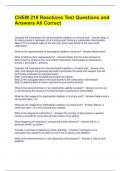
-
CHEM 210 Reactions Test Questions and Answers All Correct
- Exam (elaborations) • 3 pages • 2024
- Available in package deal
-
- $12.99
- + learn more
CHEM 210 Reactions Test Questions and Answers All Correct Describe the mechanism for the electrophilic addition of a strong acid. - Answer-Step 1) An alkene grabs a hydrogen off of a strong acid, forming a carbocation intermediate. Step 2) The conjugate base of the acid (an anion now) bonds to the open shell carbocation What is the regioselectivity of electrophilic addition reactions? - Answer-Markovnikov What is Markovnikov regioselectivity? - Answer-States that the major product is det...
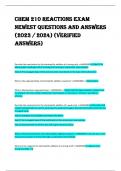
-
CHEM 210 REACTIONS EXAM NEWEST QUESTIONS AND ANSWERS (2023 / 2024) (VERIFIED ANSWERS)
- Exam (elaborations) • 15 pages • 2024
-
- $17.99
- + learn more
What is the degree of substitution? <<ANSWERS>>>The number of alkyl groups a specific carbon is bonded to (more alkyl groups means more stable) What reagents are required in a dissolving metal reduction? <<ANSWERS>>>Na or Li, ammonia (NH3) as solvent Provide a summary of dissolving metal reduction <<ANSWERS>>>2 hydrogens (one equivalent) are added to an alkyne to form the E alkene (anti addition) What is the stereochemistry of the dissolving ...
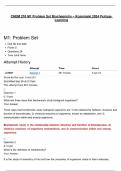
-
CHEM 210 M1 Problem Set Biochemistry – Kozminski 2024 Portage Learning
- Exam (elaborations) • 11 pages • 2024
- Available in package deal
-
- $14.39
- + learn more
CHEM 210 M1 Problem Set Biochemistry – Kozminski 2024 Portage Learning Question 1 0 / 0 pts What are three ways that biochemists study biological organisms? Your Answer: Three ways that biochemists study biological organisms are 1) the relationship between structure and function of biomolecules, 2) chemical reactions of organisms, known as metabolism, and 3) communication within and among organisms. Biochemists study 1) the relationship between structure and function of biomolecules, 2)...
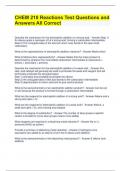
-
CHEM 210 Reactions Test Questions and Answers All Correct
- Exam (elaborations) • 3 pages • 2024
- Available in package deal
-
- $8.49
- + learn more
CHEM 210 Reactions Test Questions and Answers All Correct Describe the mechanism for the electrophilic addition of a strong acid. - Answer-Step 1) An alkene grabs a hydrogen off of a strong acid, forming a carbocation intermediate. Step 2) The conjugate base of the acid (an anion now) bonds to the open shell carbocation What is the regioselectivity of electrophilic addition reactions? - Answer-Markovnikov What is Markovnikov regioselectivity? - Answer-States that the major product is d...

-
CHEM 210 Reactions Test Questions and Answers All Correct
- Exam (elaborations) • 3 pages • 2024
- Available in package deal
-
- $7.59
- + learn more
CHEM 210 Reactions Test Questions and Answers All Correct Describe the mechanism for the electrophilic addition of a strong acid. - Answer-Step 1) An alkene grabs a hydrogen off of a strong acid, forming a carbocation intermediate. Step 2) The conjugate base of the acid (an anion now) bonds to the open shell carbocation What is the regioselectivity of electrophilic addition reactions? - Answer-Markovnikov What is Markovnikov regioselectivity? - Answer-States that the major product is d...
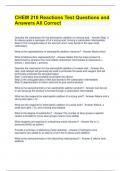
-
CHEM 210 Reactions Test Questions and Answers All Correct
- Exam (elaborations) • 3 pages • 2024
- Available in package deal
-
- $8.49
- + learn more
CHEM 210 Reactions Test Questions and Answers All Correct Describe the mechanism for the electrophilic addition of a strong acid. - Answer-Step 1) An alkene grabs a hydrogen off of a strong acid, forming a carbocation intermediate. Step 2) The conjugate base of the acid (an anion now) bonds to the open shell carbocation What is the regioselectivity of electrophilic addition reactions? - Answer-Markovnikov What is Markovnikov regioselectivity? - Answer-States that the major product is d...
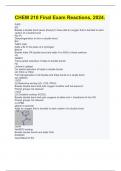
-
CHEM 210 Final Exam Reactions, 2024.
- Exam (elaborations) • 6 pages • 2024
- Available in package deal
-
- $9.99
- + learn more
CHEM 210 Final Exam Reactions, 2024. P450 [O] Breaks a double bond (even phenyl) to have add an oxygen that is bonded to each carbon of a double bond Rh/ Pt Dehydrogenation to form a double bond Br2 FeBr3 (cat) Adds a Br in the place of a hydrogen BH2-H Breaks triple OR double bond and adds H or BH2 to those carbons H2 NaNH3 Trans partial reduction of triple to double bonds H2 Lindrar's catalyst Cis partial reduction of
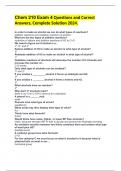
-
Chem 210 Exam 4 Questions and Correct Answers, Complete Solution 2024.
- Exam (elaborations) • 9 pages • 2024
- Available in package deal
-
- $9.99
- + learn more
Chem 210 Exam 4 Questions and Correct Answers, Complete Solution 2024. In order to make an alcohol we can do what types of reactions? addition reactions and oxidation reactions of alcohol What are the two types of addition reactions? hydration of alkene and addition reactions of H2 to C=O We need to figure out if alcohol is a... 1º, 2º, and 3º Ketone addition of H2 to make an alcohol is what type of alcohol? 2º Aldehyde addition of H2 to make an alcohol is what type of alcohol? 1...
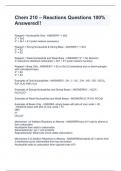
-
Chem 210 – Reactions Questions 100% Answered!!
- Exam (elaborations) • 6 pages • 2024
- Available in package deal
-
- $10.99
- + learn more
Chem 210 – Reactions Questions 100% Answered!! Reagent = Nucleophile Only - ANSWER1° = Sn2 2° = Sn2 3° = Sn1 + E1 (polar medium necessary) Reagent = Strong Nucleophile & Strong Base - ANSWER1° = Sn2 2° = E2 3° = E2 Reagent = Weak Nucleophile and Weak Base - ANSWER1°/2° = No Reaction 3°/resonance stabilized carbocation = Sn1 + E1 (polar medium necessry Reagent = Base Only - ANSWER1° = E2 or Sn2 (if unhindered and no beta-hydrogen with unhindered base) 2° = E2 3° = E...

$6.50 for your textbook summary multiplied by 100 fellow students... Do the math: that's a lot of money! Don't be a thief of your own wallet and start uploading yours now. Discover all about earning on Stuvia


